Download and use this class created flashcard set for VTNE study.
Pineado a
96
1
0
Sin etiquetas

|
Creado por Sherry Grisham-Cushing
hace más de 5 años
|
|
Cerrar

|
Creado por Sherry Grisham-Cushing
hace más de 5 años
|
|


To separate connective tissues around surface from bone. Different forms, some look like double ended stylet: one smooth flat or blunted end and one sharp end.

Used for fracture reduction and helps to stabilize broken long bones. It has screws that are placed into the bone above and below the fracture, and a stabilizing device is attached to the screws from outside the skin.

Commonly used in the metaphysis of long bones. These screws are characterized as having a thin core and wider threads which help ease insertion into the bone.

This 8” long instrument used to retract (& grasp) the uterine horns during an ovariohysterectomy in dogs and cats.

These scissors have one blade that is slightly longer with a blunt tip, allowing it to easily slide underneath the bandage material while protecting the patient’s skin from injury.

Self-retaining retractor used for holding tissues. Has a ratchet-locking mechanism and outward-facing, curved prongs that interdigitate.

Large, angled suction tip used to prevent aspiration and draw away excess fluid, smoke, or debris from the surgical site.

The manual malleability of this instrument is used to adjust and safely retract tissues and organs to keep them from obstructing the surgeon’s view. This instrument comes in different lengths and widths allowing it to be used on different regions of the body. The malleable retractor can be used in a variety of procedures, from delicate ophthalmic procedures to retracting larger organs in abdominal surgeries.
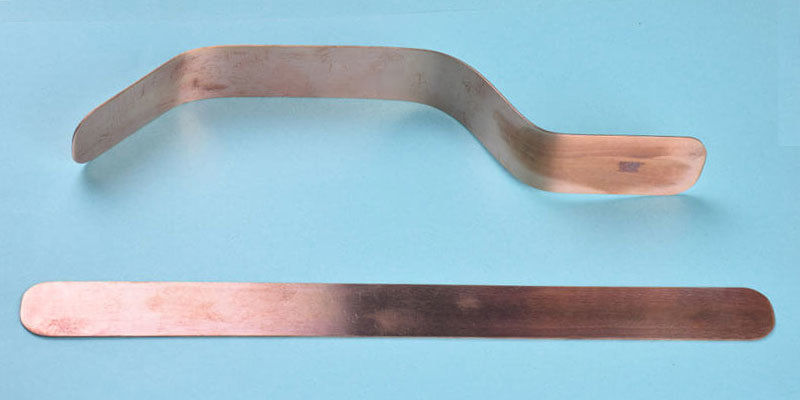
This instrument is commonly used to stabilize small and large bones during repair. It can also be used to remove bone fragments from a surgical site. The serrated jaws with two teeth help provide a secure grip on bones. The ratchet mechanism and curved plier handles provide additional grip and stabilization by allowing them to be clamped securely onto the bone.

Needle used to perform bone marrow biopsies. It is a cylindrical needle with tapered cutting tip that reduces potential crush artifacts.

Metal skin sutures that vary in size. Each clip is 2 mm wide band of metal that have a downward sharp prong to each end. Almost like a skin staple. The can be applied to wounds and are used for temporarily as part of a procedure to stop blood flow. However, can be easily removed by rubbing.

Its function is to drive suture needles through tissue that requires suturing and to assist in tying sutures. The scissors blades are set behind the jaws. After the suture is tied into a knot, the surgeon can cut the suture with the same instrument

It’s function is to hold open tissue or muscle within a wound or incision so that the surgeon can view the underlying tissues. The retractor ends in three pronged, sharp or blunt, points that curve. It works well with smaller incisions and wounds. The pronged end can be used to spread incisions and provide better visibility of the surgical site. The flat end can be used either as a handle or to spread small incisions.

A self-retaining, small spreader used to retract tissue.
The ring-handle design includes a ratchet that is able to control the spread of the blades and lock them in place. These blades have tips that are turned sideways at right angles. In this way, small incisions can be held apart during surgeries.

Stainless steel orthopedic wire used for long term implantation; often in conjunction w/ pins, plates or screws. It helps with encircling the bone or bone fragments and twisting the ends in a twist -tie. Stainless steel; sizes 16g-30g (18g, 20g & 22g most commonly used)

A curette is a debulking instrument commonly used in orthopedic procedures. It is used to scrape away and remove fibrous tissue and other debris from bone, like cartilage. It may also be used to scrape and remove small portions of the bone itself. They are also commonly used during arthroscopic surgery to debride joint surfaces and dislodge loose, bony fragments within joints.

Littauer Stitch Scissors are used for suture removal. These scissors have a small hook-shaped tip on one blade that slides under sutures to slightly lift them before cutting for removal. They should not be used for cutting tissue.
Markings- These scissors have a small hook-shaped tip on one blade

This is a thin instrument made of stainless steel. It is used for the removal of fluid or debris from small surgical spaces. Suction is controlled by a small opening on the handle and there are multiple tip sizes available.

Tenotomy scissors are made of stainless steel, they have a very long shank, short sharp jaws, and sharp tips. The blades can be either curved or straight depending on the surgeons preference and needs. They are used for delicate surgical procedures such as ophthalmic.

This type of thumb forceps used to help enable a strong grasp of the skin and fascia for sutures placements during surgery. These instruments look almost identical to tweezers yet they are known to have large interdigitating teeth at the end, which resembles a rat’s teeth hence the name.

This surgical instrument is used to occlude large blood vessels and manipulate tissues during surgery without cutting them. It can also be used for soft tissue dissection. These forceps are known to be larger than the Halstead Mosquito hemostatic forceps with only the distal half of both jaws containing transverse grooves. As they said, “Kelly is a good girl, who only went half way.”

This instrument looks similar to a standard needle holder and is “used to fasten cerclage wire in their twist-tie fashion". As seen in the photo the jaws are short and serrated. It also has a long shank compared to it's box lock.

It is a “T-shaped, reusable, stainless steel tubular instrument with a cylindrical cutting blade.”

These scissors are designed to assist in surgical procedures of the eye. They are mainly used to cut delicate tissues of the eye. They are small scissors with short pointed sharp blades. Some are manufactured to have curved blades instead of pointed. This instrument can also be used for detailed dissection of fine tissues and for fine suture removal

This instrument is used to hold suture needles when suturing tissues. They differ from the Olsen-Hager needle holder because they do not have the addition of scissors. They are available in a variety of lengths. They have a box lock in order to lock the suture needle and have better control.

Also known as K-wires. They are smooth, stainless steel bone pins used to pin small bone fragments. They are smaller than Steinmann pins and come in varying diameters (0.035 inch, 0.045 inch, or 0.062 inch). They can be driven through bone by hand with a Jacob’s chuck or by using an air powered instrument.

A double-action rongeur is a hand-held instrument with sharp, cupped tips that are used to cut small pieces of dense tissue (bone, cartilage, or fibrous tissues). They are larger and stronger than single-action rongeurs. They have a smooth cutting action and are more commonly used for removing large amounts of dense tissue. Not to be mistaken for bone cutters, which have a more chiseled tip.
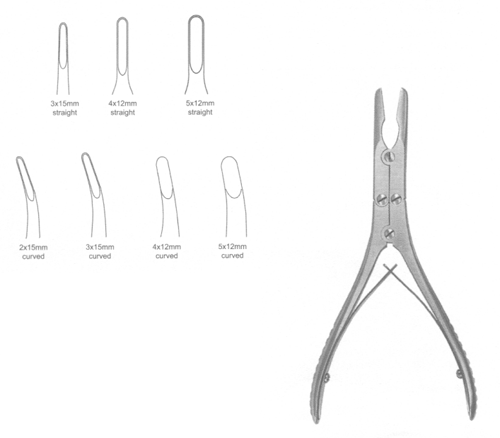
The Roeder towel clamp is a surgical instrument used to attach towels and drapes on the patient. These instruments have pointy tips that are curved and should be handled with caution. The way to identify them vs the backhaus towel clamps is by the fact that these clamps have a ball or bead attached to the jaws to prevent the towel from slipping toward the box lock of the forceps.

A Bard-Parker No.3 scalpel handle is a surgical instrument that is used to hold a blade. The handle helps to prevent direct contact with the blade for the safety of the surgeon and patient. This instrument helps to make cuts on the skin or tissue. This handle has horizontal serrations for thumb and forefinger grip. This handle fits blades 10-15. To identify from the Bard-Parker No. 4 handle an engraved number 3 will be found on the bottom of the handle. The No.3 handle is also about an inch smaller in length than the No.4.

Rochester-Pean forceps are used to temporarily clamp larger tissues and blood vessels. They are characterized by both jaws having transverse grooves all the way up the hinge which allows for good crushing action. They are commonly referred to as “Big Kelly.”

Bone plates are a thin metal bar engraved with screw openings. They are designed to immobilize bone segments in situations where casts cannot be applied. Bone plates must be strong enough to support the bone during the healing process.

Adson Thumb Forceps are used to pick up and maneuver delicate tissue. The very fine teeth on each of the tines cause minimal trauma when picking up and temporarily holding soft tissue. The usual length is 4 3/4 inches: it is available in 1x2 and 2x3 tooth arrangements, with either standard or delicate tines. It has a wide blade to allow thumb and finger pressure without fear of tissue rotating out from between the fingers.
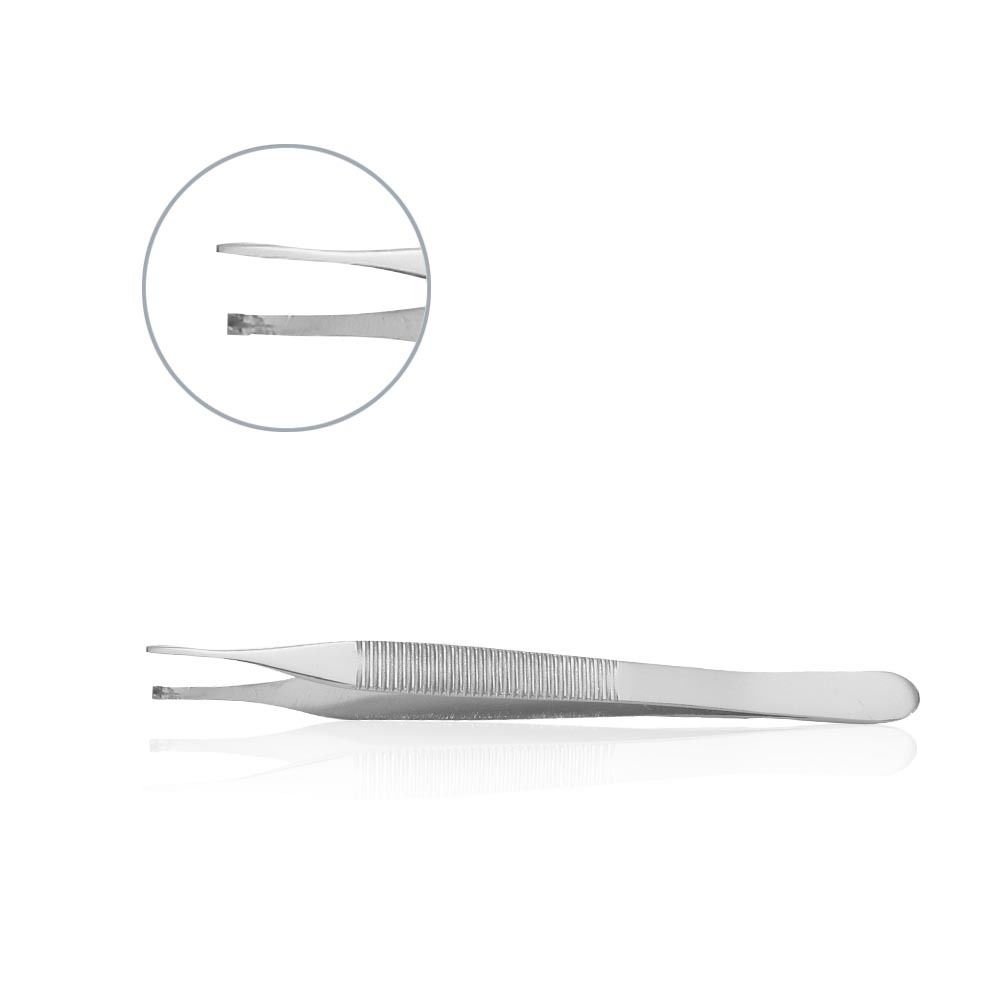
The function of Metzenbaum dissecting scissors is to blunt-dissect or cut soft tissues. The fine blades on this scissors are approximately 1 1/2 inches long and have blunt or pointed tips. Their lengths can be 4 1/2, 5 3/4, or 7 to 11 inches, but the most common length is 7 inches. The blades can be straight or curved, smooth or serrated. This scissors should never be used to cut suture material or bandaging material because doing so dulls the blades. (Blunt dissection involves introducing the closed blades into an area; the blades are then open and pulled backward through the tissues.) Blunt dissection stretches the small capillaries so they do not bleed, and it prevents the accidental cutting of tendons, ligaments, and large blood vessels.
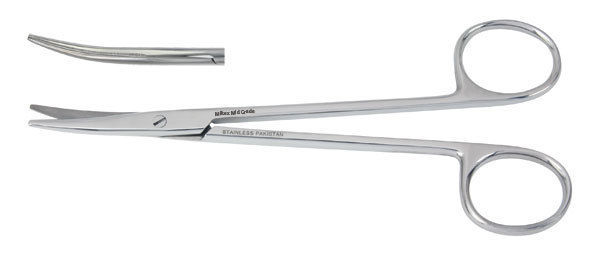
These scissors are designed to cut wire sutures , scissors have a blunted opening with curved “jaws”. They are made of stainless steel and can also be used for orthopedic surgeries .

Allis Forceps are used in veterinary medicine to hold tissue out of the way or “retract” the tissue from the primary surgical field. The interlocking teeth hold the issue firmly and can cause tissue damage. Allis Tissue Forceps creates a strong hold on fascia and tendons but should not be used for delicate tissues. The forceps come in varying sizes and have a distinct A shape with a small parting between the distal clamping ends.

Crile Hemostat forceps are used to clamp blood vessels and tissue before ligation or cauterization in surgical procedures. These forceps have striations that are horizontal down the entire length of both jaws. Crile Hemostats are made in a number of sizes and shapes being straight or curve tipped. The easiest way to identify these forceps are to look at the striations and check if they are horizontal and down the entire length of the jaws not half-way or vertical like other forceps.

“Osteo”= bone and “tome” = to cut or incise. Similar in shape to a chisel, the osteotome is used to cut, divide or prepare the bone by applying the cutting edge on the bone and tapping the flat, non-cutting end with a mallet. The osteotome’s tapered cutting edge is beveled on both sides, unlike a chisel that is only beveled on one side. The cutting edge comes in varying widths (2mm – 20mm) and can be either straight or curved. The osteotome is typically used in either orthopedic or dental surgical procedures.

Steinmann pins are smooth and composed of stainless steel. They are referred to as intramedullary pins since they are often inserted into the intramedullary cavity of long bones as a means of stabilizing a fracture of the bone. They come in varying lengths (3” to 20”), diameters (1/16” to ¼” or 1.6mm to 6.5mm) and pin point shapes (chisel, trocar or threaded trocar), which can apply to one end or both ends of the Steinmann pin. The pin is usually inserted into the long bone by hand with a Jacob’s chuck or by using a low speed drill.

A cutting wire that is actually made up of multiple, flexible wires twisted in such a way to create multiple cutting edges. It is wrapped around bone to be cut and T handles or loops where handles hook in are held, then hands are moved back and forth in as the wire cuts through desired bone. Very difficult to clean (bone fragments embedded in wire) and generally considered single use.

The Hand chuck is a type of drill used in orthopedic fracture repair to hold and place wires and pins. The key is twisted to tighten the pin. It is commonly used in external fixation procedures.

These forceps have ring handles, a ratchet mechanism, and blades with a triangular orifice. There are horizontal grooves at the terminal on one blade and ridges on the other blade. The ridges fit into the grooves, securing the held structure and prevent movement. This instrument is non- traumatic. Uses include grasping or encircling delicate tissues or tubular organs such as the appendix, caecum, intestines, or uterus without crushing or traumatizing it.

These forceps are available in various lengths and tip dimensions. They have narrow tips with serrated teeth that are commonly used for holding fine tissue and blood vessels or dissecting soft tissue. They are atraumatic tissue forceps used in vascular procedures to avoid tissue damage.

This has a pair of chiseled-like tips used for cutting bone. They can be easily mistaken for wire cutters, however bone cutters have finer jaws. A rough wire is attached to or can be attached to handles. The wire is placed around a bone or horn, and a back-and-forth motion cuts through the matter with minimal effort.

This instrument has multiple intermeshing teeth along with a broad tip which allows for good needle and tissue handling. They are typically used for holding and manipulating tissues that are more delicate. There is a flat area on both sides of the instrument with horizontal striations that is to be grasped by the thumb and finger.

It is a double-ended retractor with a fenestrated handle. The blades at each end are angled 90 degrees and also have a slightly curved, rounded lip. The blades also face in the same direction. One end has a shorter blade then the other. This instrument is commonly used to retract large muscle groups during neurological and orthopedic procedures.

Mainly used for ophthalmic procedures to keep the eye open during surgery. It should be strong enough to retract the lids easily but sufficiently lightweight to prevent direct pressure on the globe

A double spring surgical instrument used for holding small, delicate needles in various microsurgical procedures. It is without a lock usually possess a pin stop to prevent excessive compression of the handles damage the tips

Used to cut stainless steel wire, which is commonly used in orthopedic surgery. These scissors are short, compact blades that are serrated (they have tiny teeth). The blades may be angled or straight with a length of 4¾ inches typically.

This instrument has a spring action and the jaws are opposed by manually compressing the two metal handles together. It has long narrow jaws with multiple delicate sets of teeth, good for vascular surgery.

A versatile instrument that is made for trimming and cutting lengths of wire. Typically they have tungsten carbide jaws for a stronger grip and a golden handle for easy identification. There are many different types.

A surgical handle that is supposed to be used with an appropriate blade which will be used for tissue separation, and other procedures that require a sharp surgical blade to puncture or cut. To identify it from the Bard-Parker No.3 handle you will look for a 4 engraved into the handle towards the end of the handle. Some handles may have markings made for measuring in cm. This blade holder is about an inch longer than the usual No. 3 scalpel handle, which can be another way to identify between the two-No.3 and No.4

Wire cutters are used to cut orthopedic wire. They look similar to bone cutters but should not be mistaken. This instrument is made for trimming and cutting various length of wire in orthopedic surgery. This instrument has sharp angled cutting edges at the jaw.

A double spring surgical instrument used for holding small, delicate needles in various microsurgical procedures, for example, a cherry eye surgery. A way to identify this instrument is that it is smaller compared to other instruments, ratio wise. This instrument is delicate which is a good way to identify it and you will agree that it belongs for microsurgical procedures. This instrument has needle holders without a lock which possess a pin-stop to prevent excessive compression of the handles which would damage the tips.

This surgical instrument has short jaws that are fully serrated and fine tips. They are typically used to clamp off small blood vessels due to their delicate size. They have a ratcheted locking handle which provides a secure grip to stop blood flow. They can also be used to grasp and manipulate small objects.

This instrument is used for general multi-purpose cutting. Primarily used to cut sutures, paper drape material, tubing, or gauze. Not usually used to cut tissues. Available with multiple tip configurations- blunt/blunt, sharp/sharp, and sharp/blunt. They come in lengths of 4½, 5, 5½, and 6½ inches (the last being the most common). Blunt-blunt have blades that are rounded; sharp-blunt have one rounded and one pointed blade; sharp-sharp have two blades that are pointed. The most common is the sharp-blunt.

Used in abdominal procedures. Features a frame with center blade and adjustable side arms.

Instrument used to suction large quantities of fluid from surgical sites. i.e. the abdominal or thoracic cavity.
The suction tube has multiple holes to prevent blockages from tissue such as fat

This instrument is a re-tractor that spreads out the ribs creating more space in between during thoracic surgery.

These screws are used to hold plates to the long bones. There are two basic screw styles, cancellous and cortical. Cortical screws are stronger than cancellous screws and they are more closely spaced. Their threads are optimally designed for use in hard cortical bone.

A heavy duty orthopedic instrument made of stainless steel used to cut or remove small pieces of bone during surgery in a sharp, scooped-shaped cutting motion.

The lid speculum is an instrument mainly used for ophthalmic procedures to keep the eye open during surgery. There are various ones with very minimal differences between them but all have the same basic structure and same purpose. A common one is the Barraquer wire speculum.

Hand held and (air) nitrogen driven. Are used for grinding down bone with the use of burrs. Are used in neurosurgical procedures such as laminectomies.

Are used in cavities of long bones. Usually used in diaphyseal fractures, Common places are femur, humerus, and tibia.
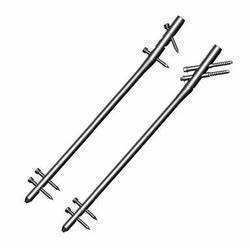
Used in conjunction with a mallet for removing/splitting pieces of bone in orthopedic surgeries.

Used to grasp dense tissue, and commonly used to hold the tissue during wound debridement and closure. Additionally, they may be used during dental procedures. The large, rounded, scoop ends have deep teeth that provide surface area and secure grip which is useful for grasping tooth fragments and placing or removing the gauze.

Heavily used forceps that can be either straight or curved and in multiple lengths. This instrument has horizontal serrations down the entire length of the jaw and teeth at the tip. The serrations make it a good option to aggressively grasp medium to heavy tissue or occlude heavy, dense vessels. The combination of full serrations plus teeth ensures a grip on the tissue or vessel being held.

The Hohmann Retractor is typically used in orthopedic procedures to pull away soft tissue from the bone tissue being operated on. It consists of a single blade and handle that are used to lever tissues out of the way for better visibility
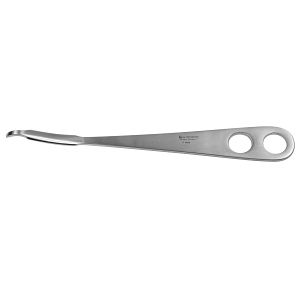

 Ocultar las fichas que te sabes
Ocultar las fichas que te sabes